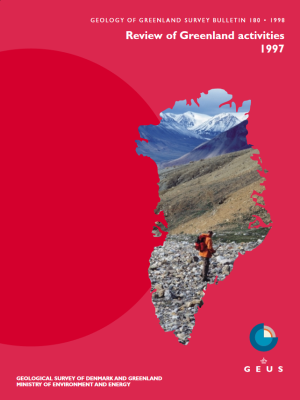North-East Greenland 1997–1998: a new 1:500 000 mapping project in the Caledonian fold belt (72°–75°N)
DOI:
https://doi.org/10.34194/ggub.v180.5095Abstract
The Geological Survey of Denmark and Greenland (GEUS) continued in 1997 the systematic geological mapping programme for the 1:500 000 regional map series, with initiation of field work on sheet no. 11, which covers part of North-East Greenland. Of the 14 planned map sheets at 1:500 000 which will cover all of Greenland, 11 have been published, and one additional sheet for which field work has been completed is under compilation. Only two areas of Greenland are not yet covered by map sheets of this series: part of North-West Greenland (sheet no 6) and the target for the present project in North-East Greenland (sheet no. 11). The field work for the latter sheet is planned for two seasons, with the first season completed in 1997 and the second and final season to follow in 1998. The map sheet (no. 11) covers the region between Kong Oscar Fjord and the Stauning Alper in the south (72°N) and Kuhn Ø and Grandjean Fjord in the north (75°N, Fig. 1). The western part of this region is dominated by crystalline complexes of the East Greenland Caledonian fold belt. A post-Caledonian sequence of Upper Palaeozoic and Mesozoic sediments and Tertiary plateau basalts and intrusions covers the eastern part of the region. This article focuses on the Caledonian geology, whereas results from the work in the post-Caledonian sediments are described in the article by Stemmerik et al. (1998, this volume). The new Survey work for map sheet 11 represents a reinvestigation of areas extensively studied by geologists of Lauge Koch’s expeditions to East Greenland (1926–58), the principal results of which were compiled by John Haller for the 1:250 000 map sheets covering the region 72°–76°N (Koch & Haller 1971) and incorporated into an impressive regional description of the East Greenland Caledonides (Haller 1971). The Scoresby Sund region to the south of latitude 72°N and the Dove Bugt region to the north of latitude 75°N have already been investigated by the Geological Survey of Greenland (Henriksen 1986, 1997; Higgins 1994) as part of the present ongoing 1:500 000 regional mapping programme. The 1997–1998 mapping project will fill the last remaining gap in the Survey’s 1:500 000 coverage of North-East Greenland. All of North-East Greenland is covered by a set of wide angle black and white vertical aerial photographs taken in the period 1978–87 from an altitude of c. 14 km. On the basis of these aerial photographs and ground control points established by Kort- og Matrikelstyrelsen (National Survey and Cadastre – formerly the Geodetic Institute), new topographical maps of the entire region 72°–75°N, at a scale of 1:100 000, with 100 m contours, are being drawn at the Survey and will serve as a basis for the field investigations and the subsequent geological map compilations. Drawing of the topographic maps in the Survey´s photogrammetric laboratory is combined with photogeological interpretation both prior to and following the field investigations. In addition to establishing a general overview of the regional geology, the project includes activities aimed at supplementing knowledge of the economic potential of the region, in respect to both minerals (Harpøth et al. 1986) and hydrocarbons (Christiansen et al. 1992; Stemmerik et al. 1997). The field work co-ordinated by the Survey included co-operation with a geophysicist from the Alfred Wegener Institute for Polar and Marine Research (AWI), Bremerhaven, who undertook rock magnetic investigations to facilitate interpretation of an AWI aeromagnetic survey, and four Norwegian sedimentologists from Saga Petroleum whose work was integrated with a Survey group working with Mesozoic sediments (Stemmerik et al. 1998, this volume). Logistic support was also given to three groups of geologists from the University of Oslo and three geologists from Massachussetts Institute of Technology, with whom agreements on scientific co-operation had been arranged in advance. Some aspects of the project are based on funding from the Danish National Science Foundation and Carlsberg Foundation, with support for special research topics concerning the pre-Caledonian basement terrain, Caledonian metamorphism, and studies of Upper Proterozoic carbonate sediments. The field investigations in 1997 were carried out during a seven week field season between early July and late August with participation of a total of 38 persons, including 32 geologists (Henriksen 1998). The work was supported by two helicopters and a small, fixed wing, Twin Otter aircraft, which operated from Mestersvig, a former airport which is kept open for limited special operations by the military sledge patrol Sirius. The GEUS group benefitted substantially from base facilities at Mestersvig, organised and manned by the Danish Polar Center (DPC). Transport between Mestersvig and Denmark was carried out by the Royal Danish Air Force (RDAF) using a C-130 Hercules aircraft.
Downloads
Published
Issue
Section
License
This article is distributed under a CC-BY 4.0 licence, permitting free redistribution and reproduction for any purpose, even commercial, provided proper citation of the original work. Author(s) retain copyright over the article contents.


